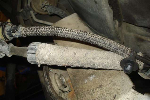Some more info..
I stumbled across some nice info about our belowed O2 sensors.
I thought I should contribute with it:
Sensor Testing:
The Lambda Sensor is at the heart of emission control continually monitoring the exhaust gas. Carbon Monoxide (CO) is produced by the engine. If the mixture supplied is too rich then CO will be high and visa versa. Having plenty of fuel (Rich) the engine will try to burn as much as possible, using up all available Oxygen, conversely if there is not sufficient fuel to maintain a correct burn then the excess Oxygen will pass into the exhaust system.
Rich mixture = High CO = Low Oxygen
Weak mixture = Low CO = High Oxygen
The Zirconia lambda sensor, by using precious metals, can determine the Oxygen difference between atmosphere and the exhaust gasses. The greater this difference, the higher the voltage it will produce, up to app 1volt. Lambda sensors will not operate until around 300 deg. They are heated by the exhaust and often have their own heater element. Single & twin wire lambda sensors have no heater element and are usually situated near or in the manifold, three & four wire sensors have an built in heater to aid rapid warmup and may be placed further downstream.
From the table it can be seen that the voltage produced changes significantly within the window lambda 0.97 - 1.03. The ECU monitors this voltage and can correct the mixture strength (by changing the injector open time) to try to maintain perfect combustion.
The sensor can be tested for output by connecting to it a digital voltmeter, set to a 2v scale. Connect the +ve test lead to the sensor signal wire and the -ve test lead to earth/battery -ve. The voltage produced should swing from app 0.2v to 0.8v and back around once per second. If the voltage is stuck high then the engine is probably running rich for some other reason. If stuck low then usually either a faulty Lambda Sensor, air leak or an engine running very weak for some reason.
The newer type of lambda sensor (titania) work on a different principle, changing a supplied voltage as against creating one, but they still measures the Oxygen differences. These later types are generally more accurate and responsive.
Common Sensor Faults:
A: Antifreeze Contamination
Antifreeze in the exhaust will attack and destroy the sensing element. A leaking head gasket commonly causes antifreeze contamination.
B: Rich Fuel Mixture
This will cause a heavy black carbon layer to form on the sensor element. Rich fuel mixture is usually caused by a failure in the air/fuel metering system
C: High Oil Consumption
This will coat the sensing element with a crusty, brown layer. Worn piston rings and valve guides, or other internal engine problems can cause high oil consumption.
D: Silicone Poisoning
Residue from silicone lubricants will rapidly destroy the sensor’s element. Care should be exercised not to get silicone lubricants on the oxygen sensor when it is being installed.
Common Sensor Variations.
To be sure of fitting the correct replacement oxygen sensor it is good to have an understanding of the different types. The most common is the zirconia dioxide (Zirconia) sensor, which comes in heated and unheated form. There are two different types of zirconia sensor and some manufacturers use titanium dioxide (titania) oxygen sensors. Below is a general overview of each type of oxygen sensor:
Zirconia 'thimble' type
Element type - zirconium dioxide, thimble
Types available - one, two, three and four wire, 18mm thread
Heater resistance - (3 and 4 wire sensors only) 2 to 6.5 ohms
Output signal - oscillating 0.1 and 0.9 volts
Zirconia ‘thick film’ type
Element type - zirconium dioxide, planar
Types available – four wire, 18mm thread
Heater resistance - 12 to 15 ohms
Output signal - oscillating between 0.1 and 0.9 volts
Titania
Element type - titanium dioxide, planar
Types available - three and four wire 12mm and 18mm thread
Heater resistance - 4 to 7 ohms.
Output signal - oscillating between 0 and 1 volt or between 0 and 5 volts
(depending on make and number of wires)
Lean Burn
Element type - zirconium dioxide, thimble or planar
Types available - four wire, 18mm thread
Heater resistance - 12 to 15 ohms
Output signal - discrete voltage levels between 0 and 5 volts
Function:
The Oxygen Sensor (also known as Lambda Sensor) is located in the exhaust manifold and measures the amount of unburned oxygen in your engine's exhaust. Based on the amount of oxygen, it sends a signal to your engine computer which then adjusts the air/fuel mixture for optimum engine performance and emission control.
Failure Symptoms:
Excessive fuel consumption, a faulty oxygen sensor can waste 30% of your fuel.
Driveability problems, such as engine surging or hesitation.
High hydrocarbon emissions, failing an emissions inspection.
The engine warning light may be on or service flag displayed.
The ecu/computer stores a mixture-related fault code.
When the oxygen sensor has stopped functioning completely, the catalytic converter may overheat and fail
Maintenance/Service:
Test and/or replace every 30,0000 miles.
Perform periodic emission checks.
Watch for service light.
Vehicle manufacturers recommend periodic inspection and replacement of oxygen sensor.
Quick Check List
1. Count the number of wires on the original sensor.
2. Check the colour of the wires
a. If the sensor has black, grey, purple or white wires, it will be a Zirconia sensor.
b. If the sensor has one red wire with the possible exception of some Japanese vehicles, it will be a Titania sensor.
3. If it is a Titania sensor then check the original thread size of the sensor.
* In some applications fitted with three wire Titania oxygen sensors, the output is 0 to 5 volts.












